University Case Study: Accounting for Intangible Assets AASB 138
VerifiedAdded on 2022/08/26
|14
|2946
|17
Case Study
AI Summary
This case study report provides a comprehensive analysis of AASB 138, focusing on the accounting treatment of intangible assets. The report begins with an executive summary, followed by an introduction to the standard and its implications. The discussion section identifies the impact of AASB 138, outlining the differences in accounting for acquired and internally generated intangible assets. It delves into the recognition criteria, measurement methods, and disclosure requirements, including amortization and goodwill valuation. The report also explores the reasons why organizations might be hesitant to adopt AASB 138, touching on the restrictive nature of the standard and the impact on financial statements. The study considers the standard's impact on market inefficiencies and manager's decision-making. The report concludes with a summary of the key findings and a list of references.
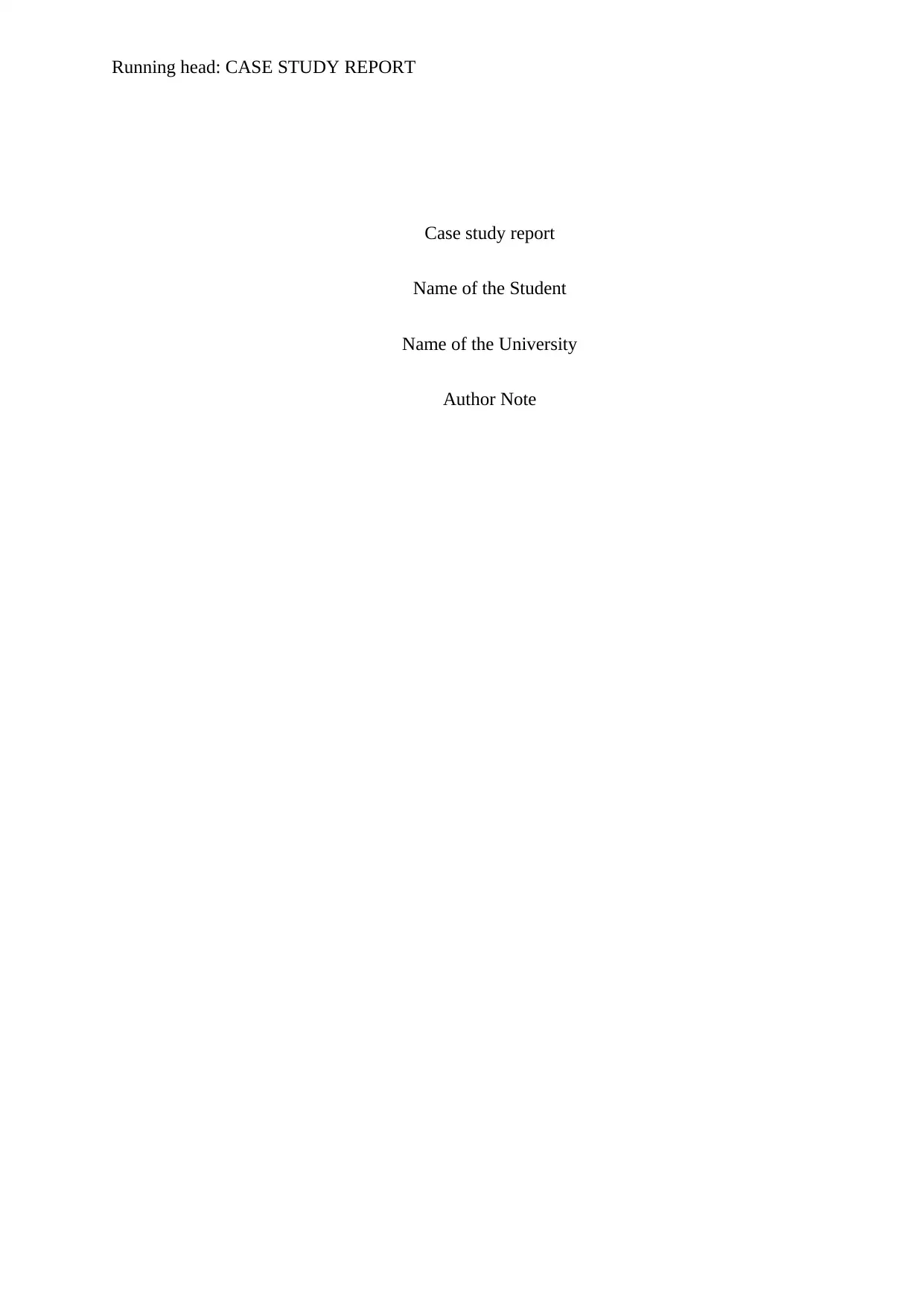
Running head: CASE STUDY REPORT
Case study report
Name of the Student
Name of the University
Author Note
Case study report
Name of the Student
Name of the University
Author Note
Paraphrase This Document
Need a fresh take? Get an instant paraphrase of this document with our AI Paraphraser
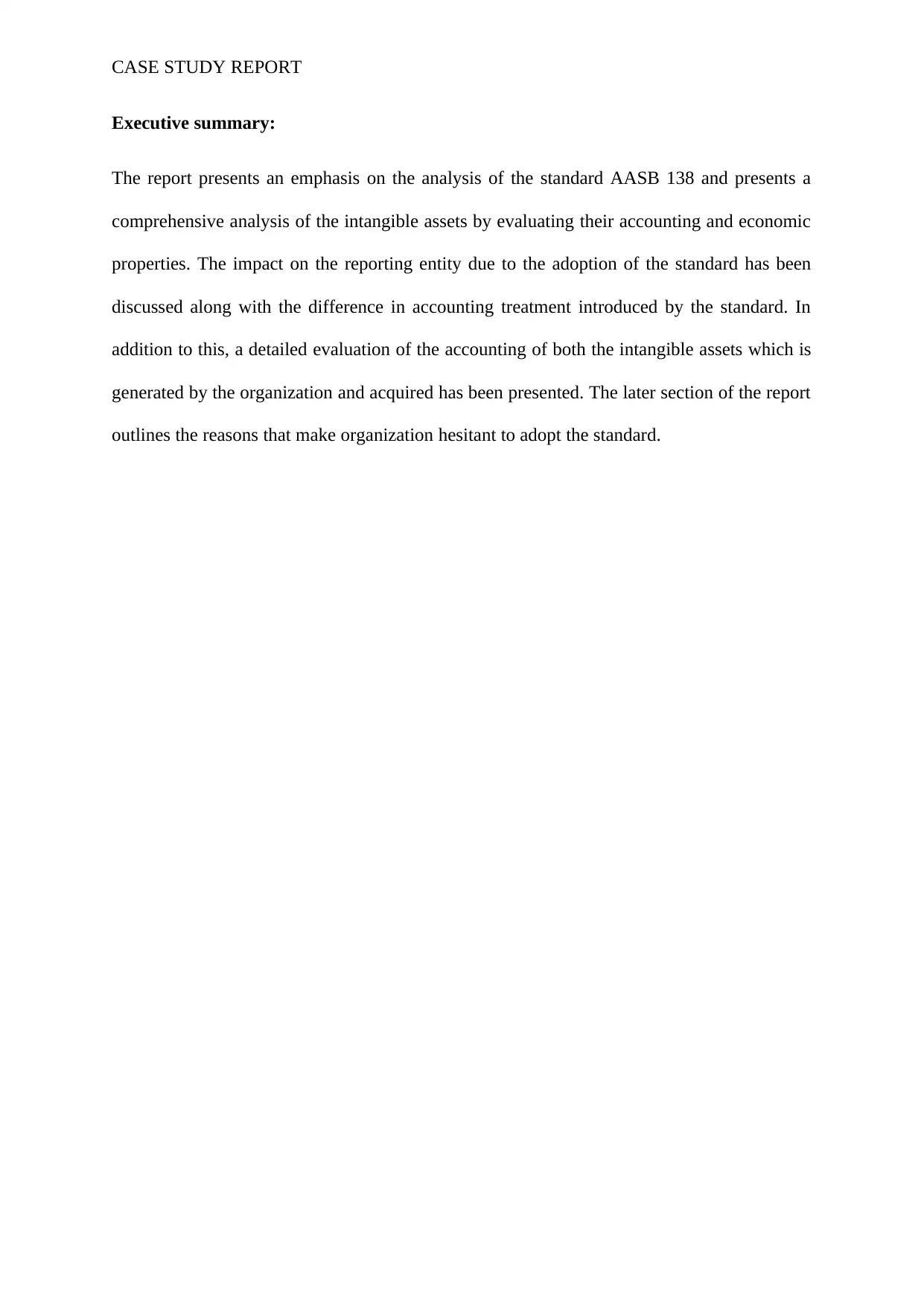
CASE STUDY REPORT
Executive summary:
The report presents an emphasis on the analysis of the standard AASB 138 and presents a
comprehensive analysis of the intangible assets by evaluating their accounting and economic
properties. The impact on the reporting entity due to the adoption of the standard has been
discussed along with the difference in accounting treatment introduced by the standard. In
addition to this, a detailed evaluation of the accounting of both the intangible assets which is
generated by the organization and acquired has been presented. The later section of the report
outlines the reasons that make organization hesitant to adopt the standard.
Executive summary:
The report presents an emphasis on the analysis of the standard AASB 138 and presents a
comprehensive analysis of the intangible assets by evaluating their accounting and economic
properties. The impact on the reporting entity due to the adoption of the standard has been
discussed along with the difference in accounting treatment introduced by the standard. In
addition to this, a detailed evaluation of the accounting of both the intangible assets which is
generated by the organization and acquired has been presented. The later section of the report
outlines the reasons that make organization hesitant to adopt the standard.
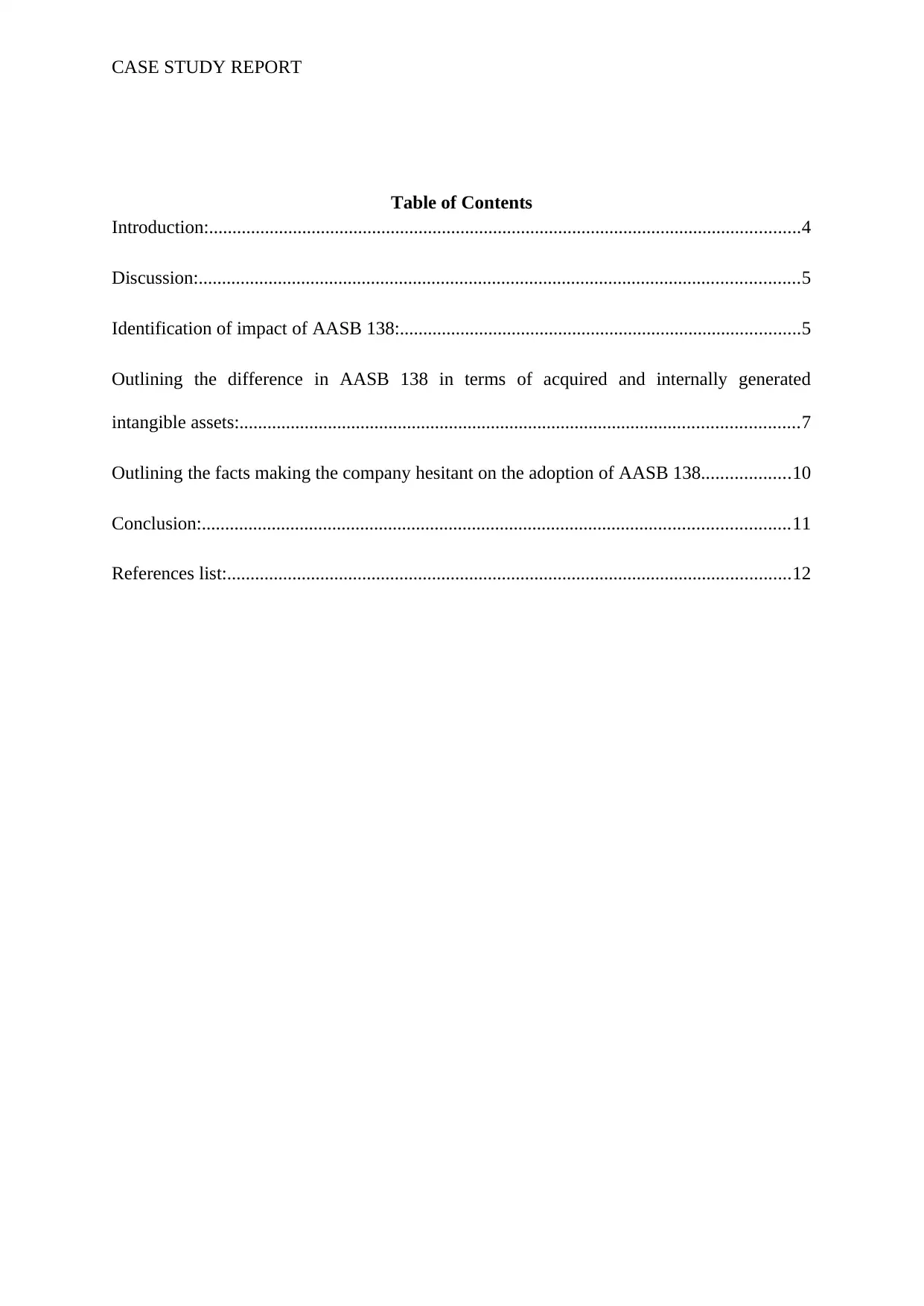
CASE STUDY REPORT
Table of Contents
Introduction:...............................................................................................................................4
Discussion:.................................................................................................................................5
Identification of impact of AASB 138:......................................................................................5
Outlining the difference in AASB 138 in terms of acquired and internally generated
intangible assets:........................................................................................................................7
Outlining the facts making the company hesitant on the adoption of AASB 138...................10
Conclusion:..............................................................................................................................11
References list:.........................................................................................................................12
Table of Contents
Introduction:...............................................................................................................................4
Discussion:.................................................................................................................................5
Identification of impact of AASB 138:......................................................................................5
Outlining the difference in AASB 138 in terms of acquired and internally generated
intangible assets:........................................................................................................................7
Outlining the facts making the company hesitant on the adoption of AASB 138...................10
Conclusion:..............................................................................................................................11
References list:.........................................................................................................................12
⊘ This is a preview!⊘
Do you want full access?
Subscribe today to unlock all pages.

Trusted by 1+ million students worldwide
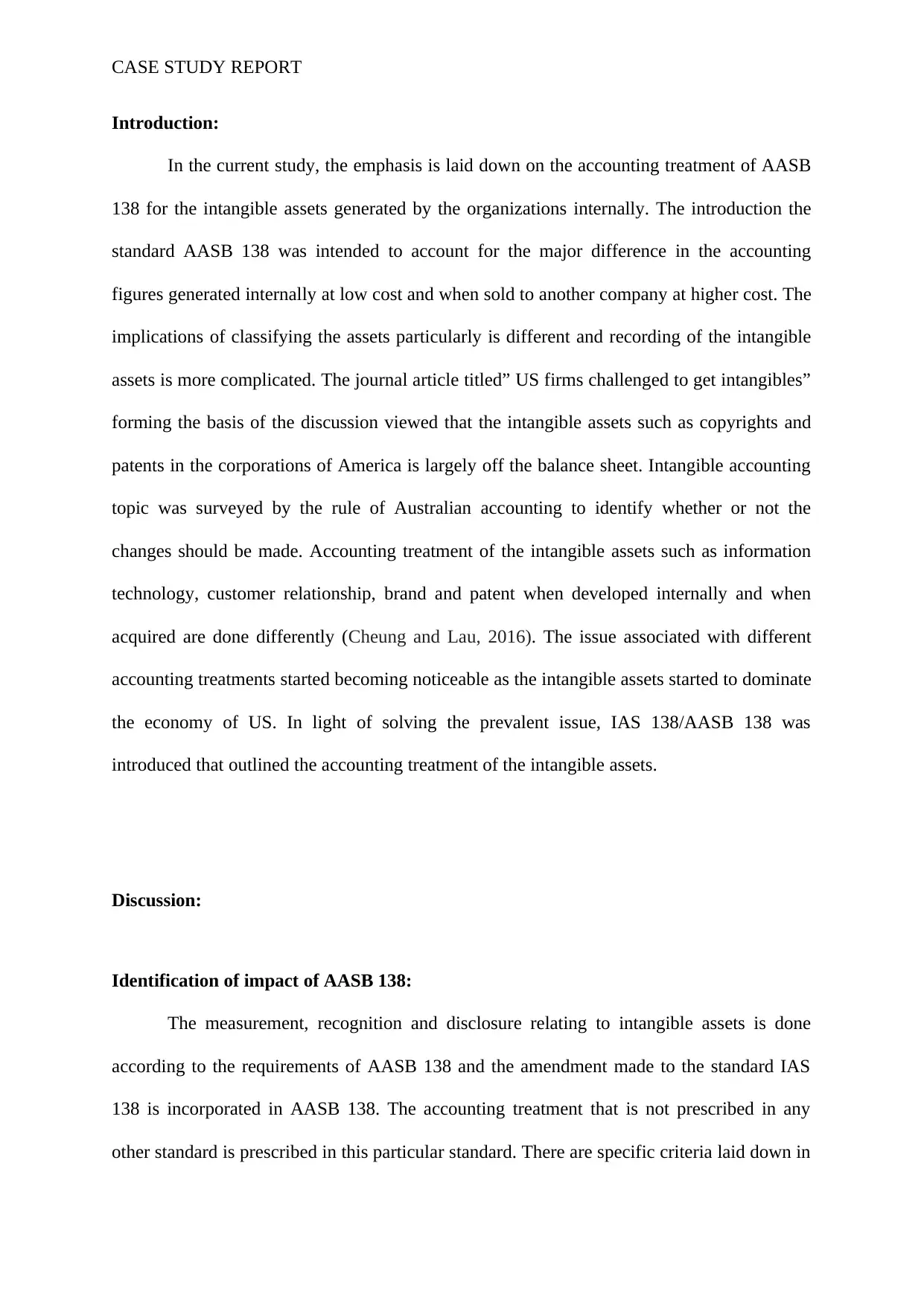
CASE STUDY REPORT
Introduction:
In the current study, the emphasis is laid down on the accounting treatment of AASB
138 for the intangible assets generated by the organizations internally. The introduction the
standard AASB 138 was intended to account for the major difference in the accounting
figures generated internally at low cost and when sold to another company at higher cost. The
implications of classifying the assets particularly is different and recording of the intangible
assets is more complicated. The journal article titled” US firms challenged to get intangibles”
forming the basis of the discussion viewed that the intangible assets such as copyrights and
patents in the corporations of America is largely off the balance sheet. Intangible accounting
topic was surveyed by the rule of Australian accounting to identify whether or not the
changes should be made. Accounting treatment of the intangible assets such as information
technology, customer relationship, brand and patent when developed internally and when
acquired are done differently (Cheung and Lau, 2016). The issue associated with different
accounting treatments started becoming noticeable as the intangible assets started to dominate
the economy of US. In light of solving the prevalent issue, IAS 138/AASB 138 was
introduced that outlined the accounting treatment of the intangible assets.
Discussion:
Identification of impact of AASB 138:
The measurement, recognition and disclosure relating to intangible assets is done
according to the requirements of AASB 138 and the amendment made to the standard IAS
138 is incorporated in AASB 138. The accounting treatment that is not prescribed in any
other standard is prescribed in this particular standard. There are specific criteria laid down in
Introduction:
In the current study, the emphasis is laid down on the accounting treatment of AASB
138 for the intangible assets generated by the organizations internally. The introduction the
standard AASB 138 was intended to account for the major difference in the accounting
figures generated internally at low cost and when sold to another company at higher cost. The
implications of classifying the assets particularly is different and recording of the intangible
assets is more complicated. The journal article titled” US firms challenged to get intangibles”
forming the basis of the discussion viewed that the intangible assets such as copyrights and
patents in the corporations of America is largely off the balance sheet. Intangible accounting
topic was surveyed by the rule of Australian accounting to identify whether or not the
changes should be made. Accounting treatment of the intangible assets such as information
technology, customer relationship, brand and patent when developed internally and when
acquired are done differently (Cheung and Lau, 2016). The issue associated with different
accounting treatments started becoming noticeable as the intangible assets started to dominate
the economy of US. In light of solving the prevalent issue, IAS 138/AASB 138 was
introduced that outlined the accounting treatment of the intangible assets.
Discussion:
Identification of impact of AASB 138:
The measurement, recognition and disclosure relating to intangible assets is done
according to the requirements of AASB 138 and the amendment made to the standard IAS
138 is incorporated in AASB 138. The accounting treatment that is not prescribed in any
other standard is prescribed in this particular standard. There are specific criteria laid down in
Paraphrase This Document
Need a fresh take? Get an instant paraphrase of this document with our AI Paraphraser
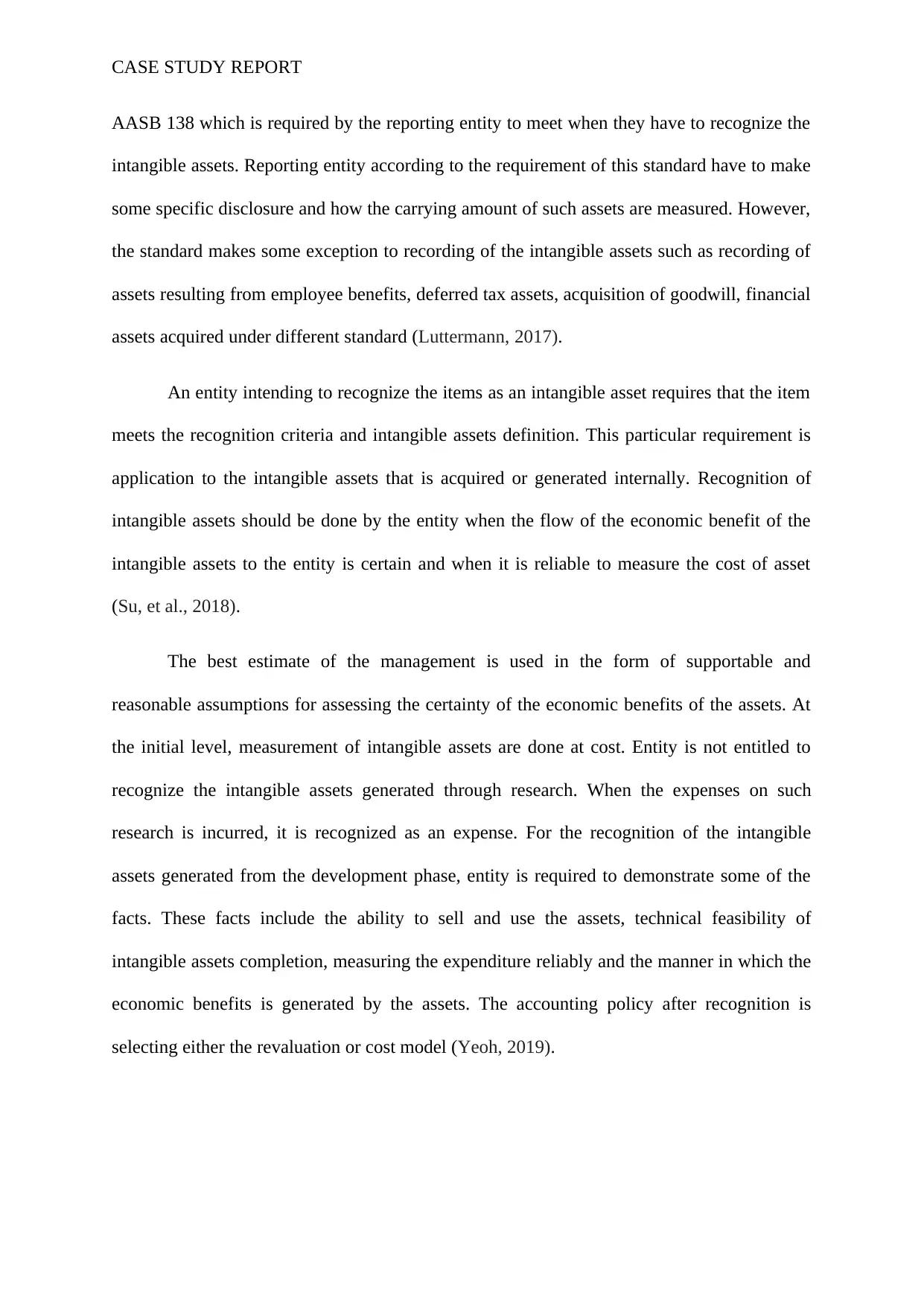
CASE STUDY REPORT
AASB 138 which is required by the reporting entity to meet when they have to recognize the
intangible assets. Reporting entity according to the requirement of this standard have to make
some specific disclosure and how the carrying amount of such assets are measured. However,
the standard makes some exception to recording of the intangible assets such as recording of
assets resulting from employee benefits, deferred tax assets, acquisition of goodwill, financial
assets acquired under different standard (Luttermann, 2017).
An entity intending to recognize the items as an intangible asset requires that the item
meets the recognition criteria and intangible assets definition. This particular requirement is
application to the intangible assets that is acquired or generated internally. Recognition of
intangible assets should be done by the entity when the flow of the economic benefit of the
intangible assets to the entity is certain and when it is reliable to measure the cost of asset
(Su, et al., 2018).
The best estimate of the management is used in the form of supportable and
reasonable assumptions for assessing the certainty of the economic benefits of the assets. At
the initial level, measurement of intangible assets are done at cost. Entity is not entitled to
recognize the intangible assets generated through research. When the expenses on such
research is incurred, it is recognized as an expense. For the recognition of the intangible
assets generated from the development phase, entity is required to demonstrate some of the
facts. These facts include the ability to sell and use the assets, technical feasibility of
intangible assets completion, measuring the expenditure reliably and the manner in which the
economic benefits is generated by the assets. The accounting policy after recognition is
selecting either the revaluation or cost model (Yeoh, 2019).
AASB 138 which is required by the reporting entity to meet when they have to recognize the
intangible assets. Reporting entity according to the requirement of this standard have to make
some specific disclosure and how the carrying amount of such assets are measured. However,
the standard makes some exception to recording of the intangible assets such as recording of
assets resulting from employee benefits, deferred tax assets, acquisition of goodwill, financial
assets acquired under different standard (Luttermann, 2017).
An entity intending to recognize the items as an intangible asset requires that the item
meets the recognition criteria and intangible assets definition. This particular requirement is
application to the intangible assets that is acquired or generated internally. Recognition of
intangible assets should be done by the entity when the flow of the economic benefit of the
intangible assets to the entity is certain and when it is reliable to measure the cost of asset
(Su, et al., 2018).
The best estimate of the management is used in the form of supportable and
reasonable assumptions for assessing the certainty of the economic benefits of the assets. At
the initial level, measurement of intangible assets are done at cost. Entity is not entitled to
recognize the intangible assets generated through research. When the expenses on such
research is incurred, it is recognized as an expense. For the recognition of the intangible
assets generated from the development phase, entity is required to demonstrate some of the
facts. These facts include the ability to sell and use the assets, technical feasibility of
intangible assets completion, measuring the expenditure reliably and the manner in which the
economic benefits is generated by the assets. The accounting policy after recognition is
selecting either the revaluation or cost model (Yeoh, 2019).
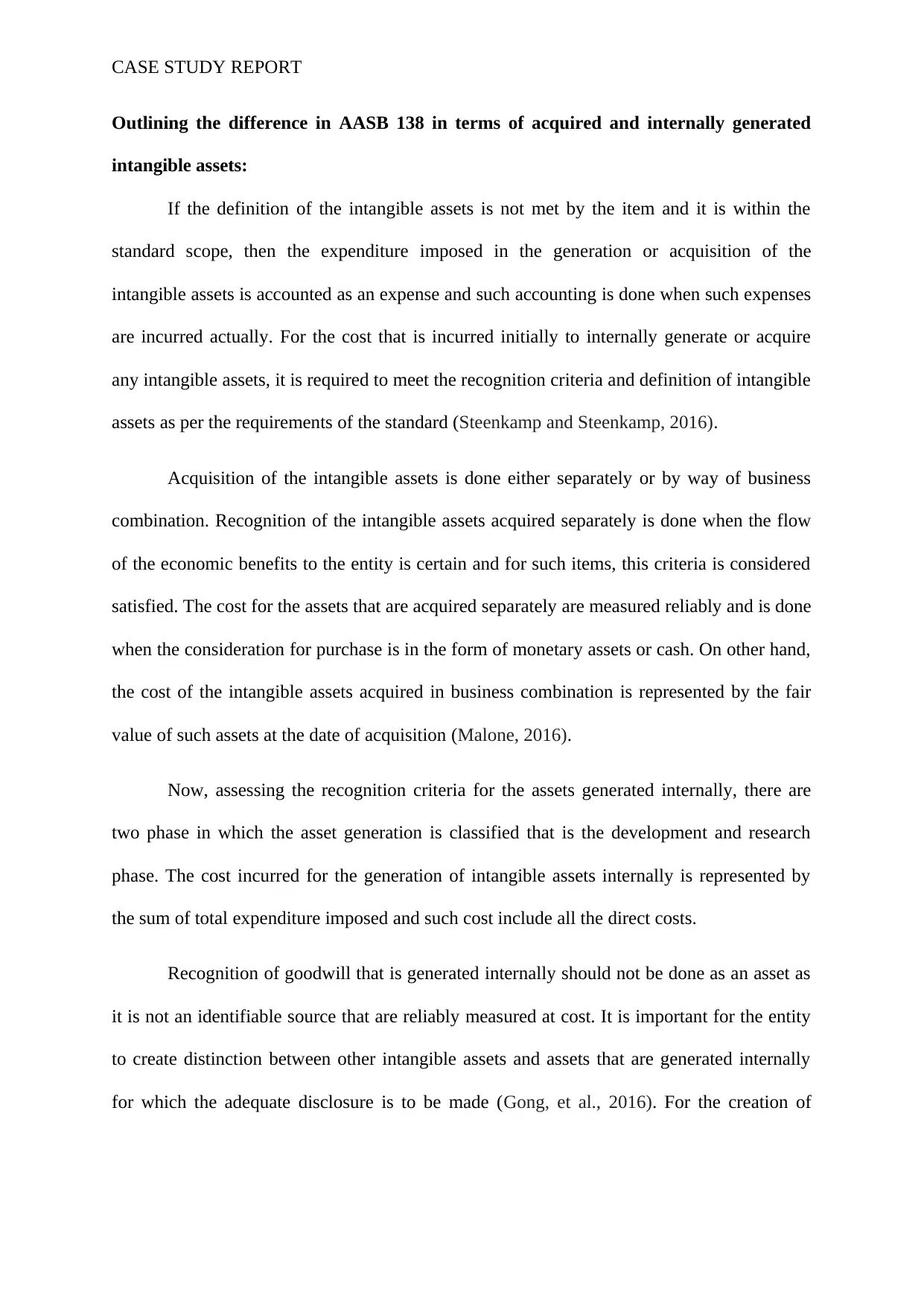
CASE STUDY REPORT
Outlining the difference in AASB 138 in terms of acquired and internally generated
intangible assets:
If the definition of the intangible assets is not met by the item and it is within the
standard scope, then the expenditure imposed in the generation or acquisition of the
intangible assets is accounted as an expense and such accounting is done when such expenses
are incurred actually. For the cost that is incurred initially to internally generate or acquire
any intangible assets, it is required to meet the recognition criteria and definition of intangible
assets as per the requirements of the standard (Steenkamp and Steenkamp, 2016).
Acquisition of the intangible assets is done either separately or by way of business
combination. Recognition of the intangible assets acquired separately is done when the flow
of the economic benefits to the entity is certain and for such items, this criteria is considered
satisfied. The cost for the assets that are acquired separately are measured reliably and is done
when the consideration for purchase is in the form of monetary assets or cash. On other hand,
the cost of the intangible assets acquired in business combination is represented by the fair
value of such assets at the date of acquisition (Malone, 2016).
Now, assessing the recognition criteria for the assets generated internally, there are
two phase in which the asset generation is classified that is the development and research
phase. The cost incurred for the generation of intangible assets internally is represented by
the sum of total expenditure imposed and such cost include all the direct costs.
Recognition of goodwill that is generated internally should not be done as an asset as
it is not an identifiable source that are reliably measured at cost. It is important for the entity
to create distinction between other intangible assets and assets that are generated internally
for which the adequate disclosure is to be made (Gong, et al., 2016). For the creation of
Outlining the difference in AASB 138 in terms of acquired and internally generated
intangible assets:
If the definition of the intangible assets is not met by the item and it is within the
standard scope, then the expenditure imposed in the generation or acquisition of the
intangible assets is accounted as an expense and such accounting is done when such expenses
are incurred actually. For the cost that is incurred initially to internally generate or acquire
any intangible assets, it is required to meet the recognition criteria and definition of intangible
assets as per the requirements of the standard (Steenkamp and Steenkamp, 2016).
Acquisition of the intangible assets is done either separately or by way of business
combination. Recognition of the intangible assets acquired separately is done when the flow
of the economic benefits to the entity is certain and for such items, this criteria is considered
satisfied. The cost for the assets that are acquired separately are measured reliably and is done
when the consideration for purchase is in the form of monetary assets or cash. On other hand,
the cost of the intangible assets acquired in business combination is represented by the fair
value of such assets at the date of acquisition (Malone, 2016).
Now, assessing the recognition criteria for the assets generated internally, there are
two phase in which the asset generation is classified that is the development and research
phase. The cost incurred for the generation of intangible assets internally is represented by
the sum of total expenditure imposed and such cost include all the direct costs.
Recognition of goodwill that is generated internally should not be done as an asset as
it is not an identifiable source that are reliably measured at cost. It is important for the entity
to create distinction between other intangible assets and assets that are generated internally
for which the adequate disclosure is to be made (Gong, et al., 2016). For the creation of
⊘ This is a preview!⊘
Do you want full access?
Subscribe today to unlock all pages.

Trusted by 1+ million students worldwide
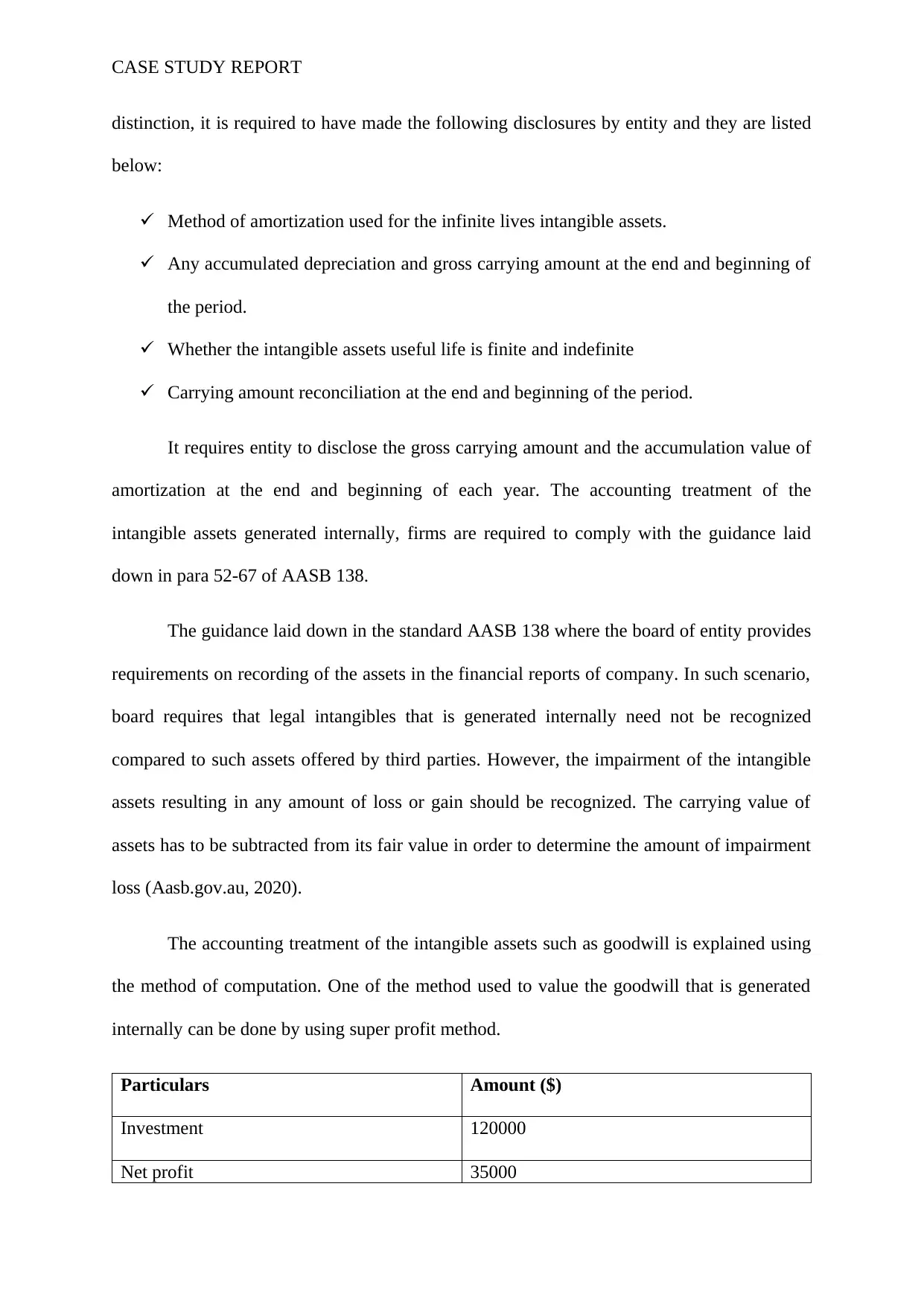
CASE STUDY REPORT
distinction, it is required to have made the following disclosures by entity and they are listed
below:
Method of amortization used for the infinite lives intangible assets.
Any accumulated depreciation and gross carrying amount at the end and beginning of
the period.
Whether the intangible assets useful life is finite and indefinite
Carrying amount reconciliation at the end and beginning of the period.
It requires entity to disclose the gross carrying amount and the accumulation value of
amortization at the end and beginning of each year. The accounting treatment of the
intangible assets generated internally, firms are required to comply with the guidance laid
down in para 52-67 of AASB 138.
The guidance laid down in the standard AASB 138 where the board of entity provides
requirements on recording of the assets in the financial reports of company. In such scenario,
board requires that legal intangibles that is generated internally need not be recognized
compared to such assets offered by third parties. However, the impairment of the intangible
assets resulting in any amount of loss or gain should be recognized. The carrying value of
assets has to be subtracted from its fair value in order to determine the amount of impairment
loss (Aasb.gov.au, 2020).
The accounting treatment of the intangible assets such as goodwill is explained using
the method of computation. One of the method used to value the goodwill that is generated
internally can be done by using super profit method.
Particulars Amount ($)
Investment 120000
Net profit 35000
distinction, it is required to have made the following disclosures by entity and they are listed
below:
Method of amortization used for the infinite lives intangible assets.
Any accumulated depreciation and gross carrying amount at the end and beginning of
the period.
Whether the intangible assets useful life is finite and indefinite
Carrying amount reconciliation at the end and beginning of the period.
It requires entity to disclose the gross carrying amount and the accumulation value of
amortization at the end and beginning of each year. The accounting treatment of the
intangible assets generated internally, firms are required to comply with the guidance laid
down in para 52-67 of AASB 138.
The guidance laid down in the standard AASB 138 where the board of entity provides
requirements on recording of the assets in the financial reports of company. In such scenario,
board requires that legal intangibles that is generated internally need not be recognized
compared to such assets offered by third parties. However, the impairment of the intangible
assets resulting in any amount of loss or gain should be recognized. The carrying value of
assets has to be subtracted from its fair value in order to determine the amount of impairment
loss (Aasb.gov.au, 2020).
The accounting treatment of the intangible assets such as goodwill is explained using
the method of computation. One of the method used to value the goodwill that is generated
internally can be done by using super profit method.
Particulars Amount ($)
Investment 120000
Net profit 35000
Paraphrase This Document
Need a fresh take? Get an instant paraphrase of this document with our AI Paraphraser
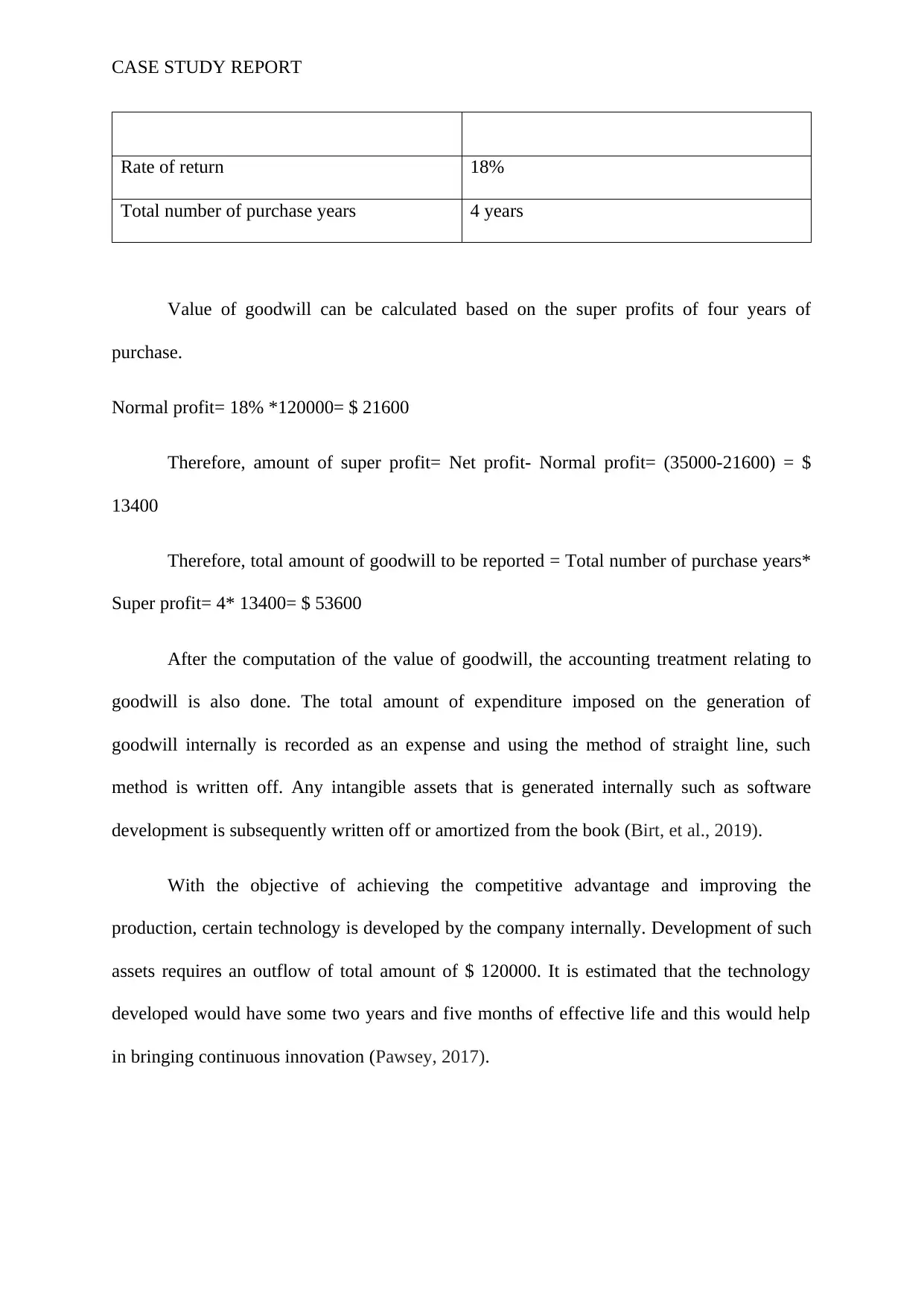
CASE STUDY REPORT
Rate of return 18%
Total number of purchase years 4 years
Value of goodwill can be calculated based on the super profits of four years of
purchase.
Normal profit= 18% *120000= $ 21600
Therefore, amount of super profit= Net profit- Normal profit= (35000-21600) = $
13400
Therefore, total amount of goodwill to be reported = Total number of purchase years*
Super profit= 4* 13400= $ 53600
After the computation of the value of goodwill, the accounting treatment relating to
goodwill is also done. The total amount of expenditure imposed on the generation of
goodwill internally is recorded as an expense and using the method of straight line, such
method is written off. Any intangible assets that is generated internally such as software
development is subsequently written off or amortized from the book (Birt, et al., 2019).
With the objective of achieving the competitive advantage and improving the
production, certain technology is developed by the company internally. Development of such
assets requires an outflow of total amount of $ 120000. It is estimated that the technology
developed would have some two years and five months of effective life and this would help
in bringing continuous innovation (Pawsey, 2017).
Rate of return 18%
Total number of purchase years 4 years
Value of goodwill can be calculated based on the super profits of four years of
purchase.
Normal profit= 18% *120000= $ 21600
Therefore, amount of super profit= Net profit- Normal profit= (35000-21600) = $
13400
Therefore, total amount of goodwill to be reported = Total number of purchase years*
Super profit= 4* 13400= $ 53600
After the computation of the value of goodwill, the accounting treatment relating to
goodwill is also done. The total amount of expenditure imposed on the generation of
goodwill internally is recorded as an expense and using the method of straight line, such
method is written off. Any intangible assets that is generated internally such as software
development is subsequently written off or amortized from the book (Birt, et al., 2019).
With the objective of achieving the competitive advantage and improving the
production, certain technology is developed by the company internally. Development of such
assets requires an outflow of total amount of $ 120000. It is estimated that the technology
developed would have some two years and five months of effective life and this would help
in bringing continuous innovation (Pawsey, 2017).
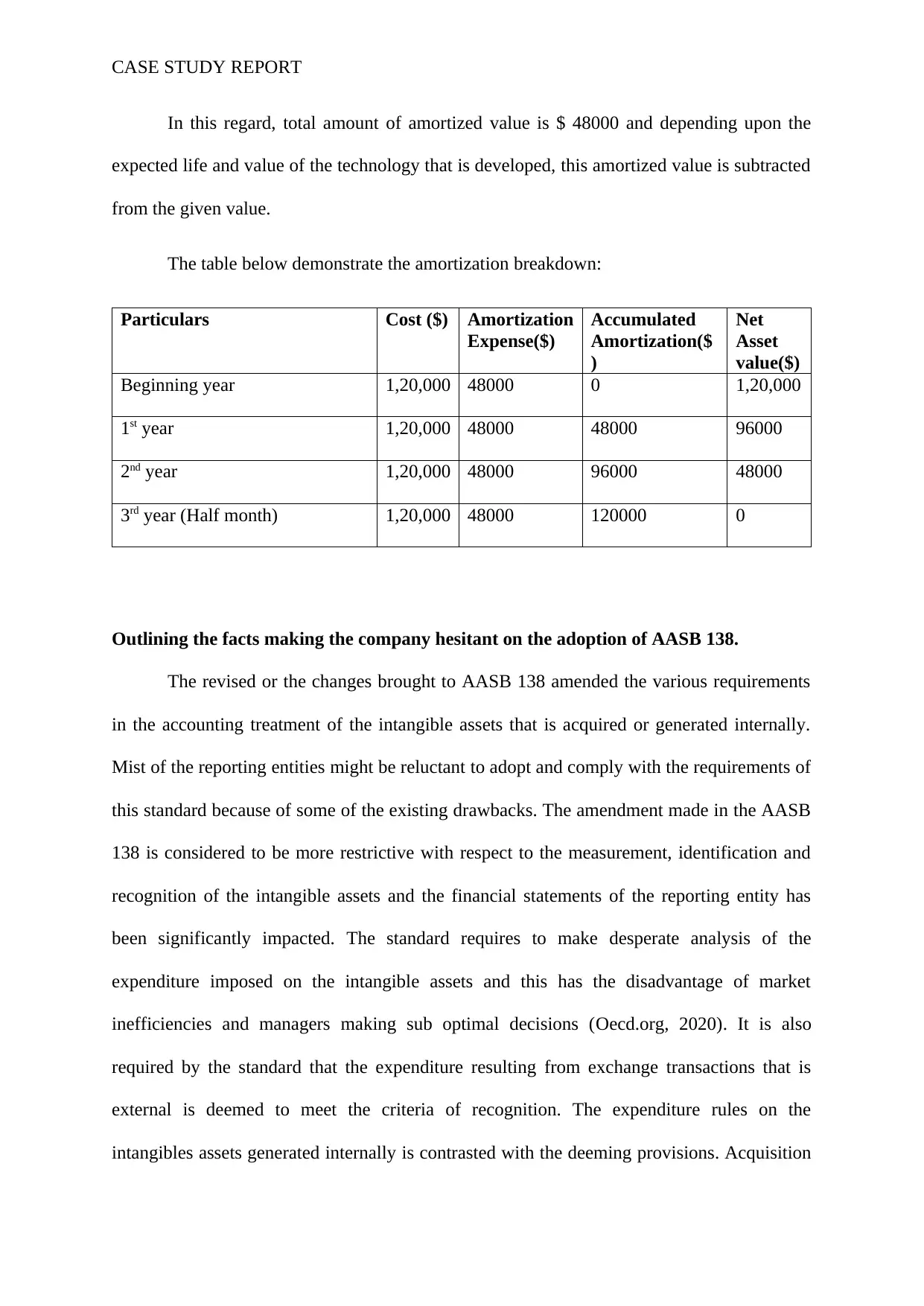
CASE STUDY REPORT
In this regard, total amount of amortized value is $ 48000 and depending upon the
expected life and value of the technology that is developed, this amortized value is subtracted
from the given value.
The table below demonstrate the amortization breakdown:
Particulars Cost ($) Amortization
Expense($)
Accumulated
Amortization($
)
Net
Asset
value($)
Beginning year 1,20,000 48000 0 1,20,000
1st year 1,20,000 48000 48000 96000
2nd year 1,20,000 48000 96000 48000
3rd year (Half month) 1,20,000 48000 120000 0
Outlining the facts making the company hesitant on the adoption of AASB 138.
The revised or the changes brought to AASB 138 amended the various requirements
in the accounting treatment of the intangible assets that is acquired or generated internally.
Mist of the reporting entities might be reluctant to adopt and comply with the requirements of
this standard because of some of the existing drawbacks. The amendment made in the AASB
138 is considered to be more restrictive with respect to the measurement, identification and
recognition of the intangible assets and the financial statements of the reporting entity has
been significantly impacted. The standard requires to make desperate analysis of the
expenditure imposed on the intangible assets and this has the disadvantage of market
inefficiencies and managers making sub optimal decisions (Oecd.org, 2020). It is also
required by the standard that the expenditure resulting from exchange transactions that is
external is deemed to meet the criteria of recognition. The expenditure rules on the
intangibles assets generated internally is contrasted with the deeming provisions. Acquisition
In this regard, total amount of amortized value is $ 48000 and depending upon the
expected life and value of the technology that is developed, this amortized value is subtracted
from the given value.
The table below demonstrate the amortization breakdown:
Particulars Cost ($) Amortization
Expense($)
Accumulated
Amortization($
)
Net
Asset
value($)
Beginning year 1,20,000 48000 0 1,20,000
1st year 1,20,000 48000 48000 96000
2nd year 1,20,000 48000 96000 48000
3rd year (Half month) 1,20,000 48000 120000 0
Outlining the facts making the company hesitant on the adoption of AASB 138.
The revised or the changes brought to AASB 138 amended the various requirements
in the accounting treatment of the intangible assets that is acquired or generated internally.
Mist of the reporting entities might be reluctant to adopt and comply with the requirements of
this standard because of some of the existing drawbacks. The amendment made in the AASB
138 is considered to be more restrictive with respect to the measurement, identification and
recognition of the intangible assets and the financial statements of the reporting entity has
been significantly impacted. The standard requires to make desperate analysis of the
expenditure imposed on the intangible assets and this has the disadvantage of market
inefficiencies and managers making sub optimal decisions (Oecd.org, 2020). It is also
required by the standard that the expenditure resulting from exchange transactions that is
external is deemed to meet the criteria of recognition. The expenditure rules on the
intangibles assets generated internally is contrasted with the deeming provisions. Acquisition
⊘ This is a preview!⊘
Do you want full access?
Subscribe today to unlock all pages.

Trusted by 1+ million students worldwide
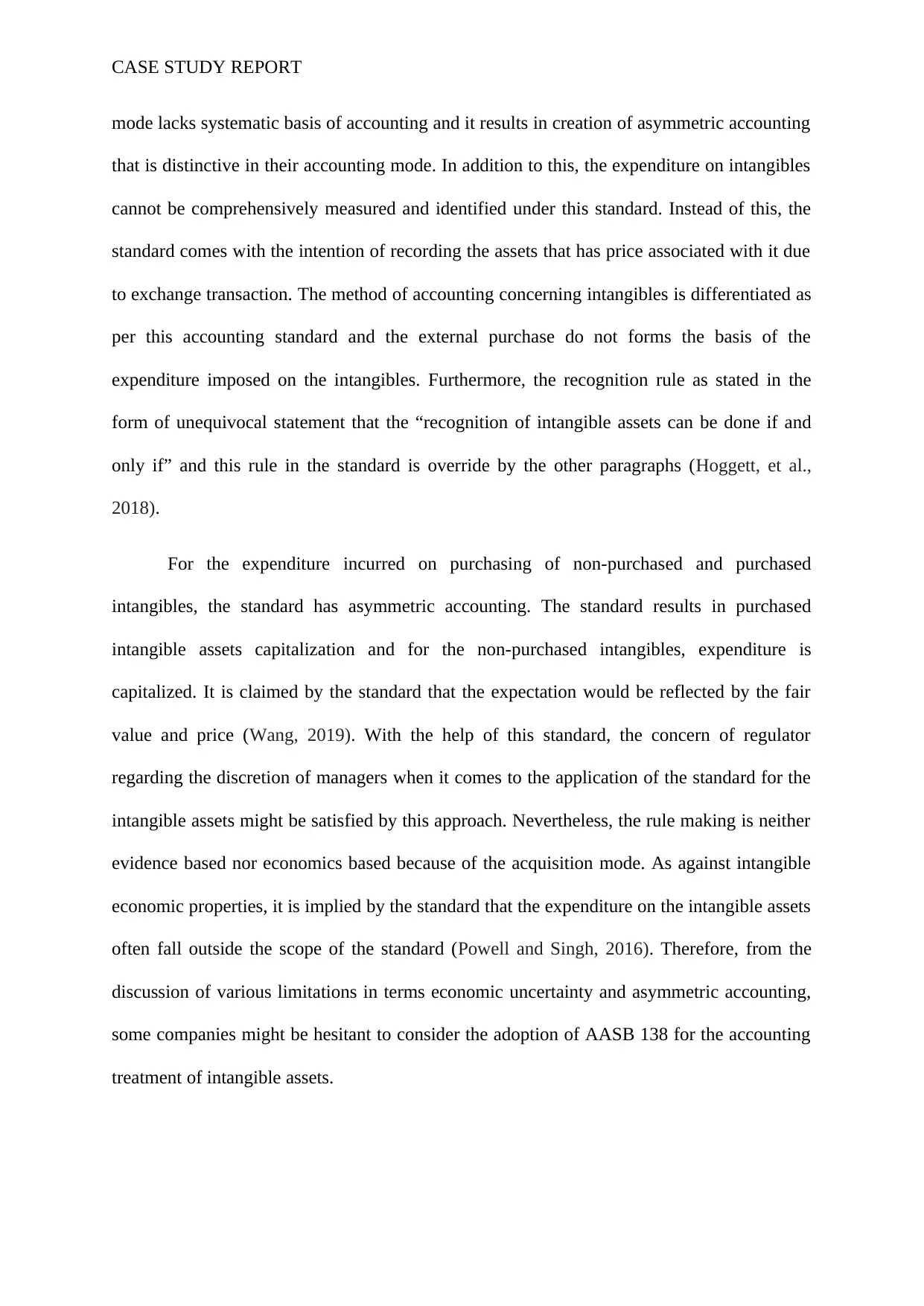
CASE STUDY REPORT
mode lacks systematic basis of accounting and it results in creation of asymmetric accounting
that is distinctive in their accounting mode. In addition to this, the expenditure on intangibles
cannot be comprehensively measured and identified under this standard. Instead of this, the
standard comes with the intention of recording the assets that has price associated with it due
to exchange transaction. The method of accounting concerning intangibles is differentiated as
per this accounting standard and the external purchase do not forms the basis of the
expenditure imposed on the intangibles. Furthermore, the recognition rule as stated in the
form of unequivocal statement that the “recognition of intangible assets can be done if and
only if” and this rule in the standard is override by the other paragraphs (Hoggett, et al.,
2018).
For the expenditure incurred on purchasing of non-purchased and purchased
intangibles, the standard has asymmetric accounting. The standard results in purchased
intangible assets capitalization and for the non-purchased intangibles, expenditure is
capitalized. It is claimed by the standard that the expectation would be reflected by the fair
value and price (Wang, 2019). With the help of this standard, the concern of regulator
regarding the discretion of managers when it comes to the application of the standard for the
intangible assets might be satisfied by this approach. Nevertheless, the rule making is neither
evidence based nor economics based because of the acquisition mode. As against intangible
economic properties, it is implied by the standard that the expenditure on the intangible assets
often fall outside the scope of the standard (Powell and Singh, 2016). Therefore, from the
discussion of various limitations in terms economic uncertainty and asymmetric accounting,
some companies might be hesitant to consider the adoption of AASB 138 for the accounting
treatment of intangible assets.
mode lacks systematic basis of accounting and it results in creation of asymmetric accounting
that is distinctive in their accounting mode. In addition to this, the expenditure on intangibles
cannot be comprehensively measured and identified under this standard. Instead of this, the
standard comes with the intention of recording the assets that has price associated with it due
to exchange transaction. The method of accounting concerning intangibles is differentiated as
per this accounting standard and the external purchase do not forms the basis of the
expenditure imposed on the intangibles. Furthermore, the recognition rule as stated in the
form of unequivocal statement that the “recognition of intangible assets can be done if and
only if” and this rule in the standard is override by the other paragraphs (Hoggett, et al.,
2018).
For the expenditure incurred on purchasing of non-purchased and purchased
intangibles, the standard has asymmetric accounting. The standard results in purchased
intangible assets capitalization and for the non-purchased intangibles, expenditure is
capitalized. It is claimed by the standard that the expectation would be reflected by the fair
value and price (Wang, 2019). With the help of this standard, the concern of regulator
regarding the discretion of managers when it comes to the application of the standard for the
intangible assets might be satisfied by this approach. Nevertheless, the rule making is neither
evidence based nor economics based because of the acquisition mode. As against intangible
economic properties, it is implied by the standard that the expenditure on the intangible assets
often fall outside the scope of the standard (Powell and Singh, 2016). Therefore, from the
discussion of various limitations in terms economic uncertainty and asymmetric accounting,
some companies might be hesitant to consider the adoption of AASB 138 for the accounting
treatment of intangible assets.
Paraphrase This Document
Need a fresh take? Get an instant paraphrase of this document with our AI Paraphraser
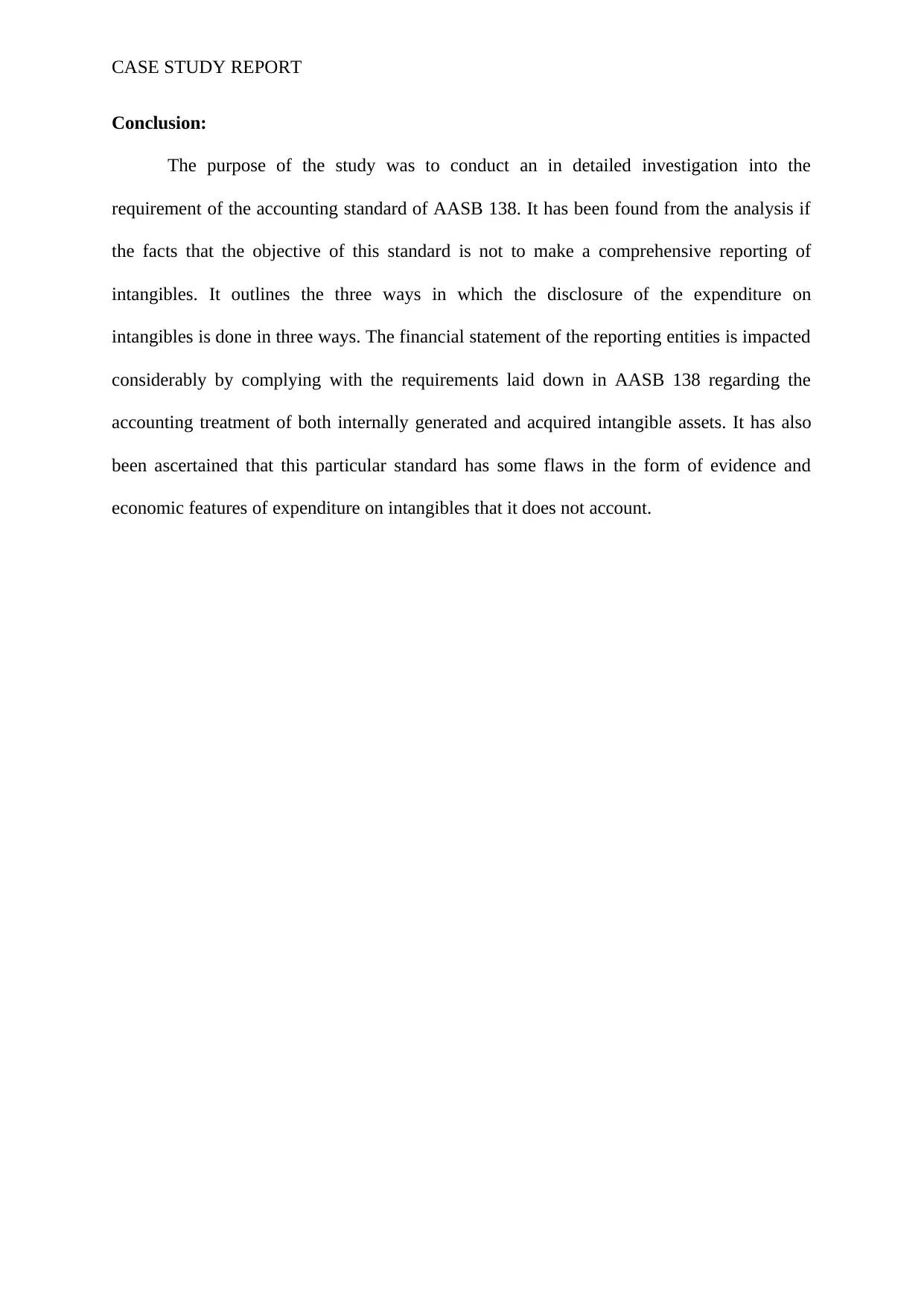
CASE STUDY REPORT
Conclusion:
The purpose of the study was to conduct an in detailed investigation into the
requirement of the accounting standard of AASB 138. It has been found from the analysis if
the facts that the objective of this standard is not to make a comprehensive reporting of
intangibles. It outlines the three ways in which the disclosure of the expenditure on
intangibles is done in three ways. The financial statement of the reporting entities is impacted
considerably by complying with the requirements laid down in AASB 138 regarding the
accounting treatment of both internally generated and acquired intangible assets. It has also
been ascertained that this particular standard has some flaws in the form of evidence and
economic features of expenditure on intangibles that it does not account.
Conclusion:
The purpose of the study was to conduct an in detailed investigation into the
requirement of the accounting standard of AASB 138. It has been found from the analysis if
the facts that the objective of this standard is not to make a comprehensive reporting of
intangibles. It outlines the three ways in which the disclosure of the expenditure on
intangibles is done in three ways. The financial statement of the reporting entities is impacted
considerably by complying with the requirements laid down in AASB 138 regarding the
accounting treatment of both internally generated and acquired intangible assets. It has also
been ascertained that this particular standard has some flaws in the form of evidence and
economic features of expenditure on intangibles that it does not account.
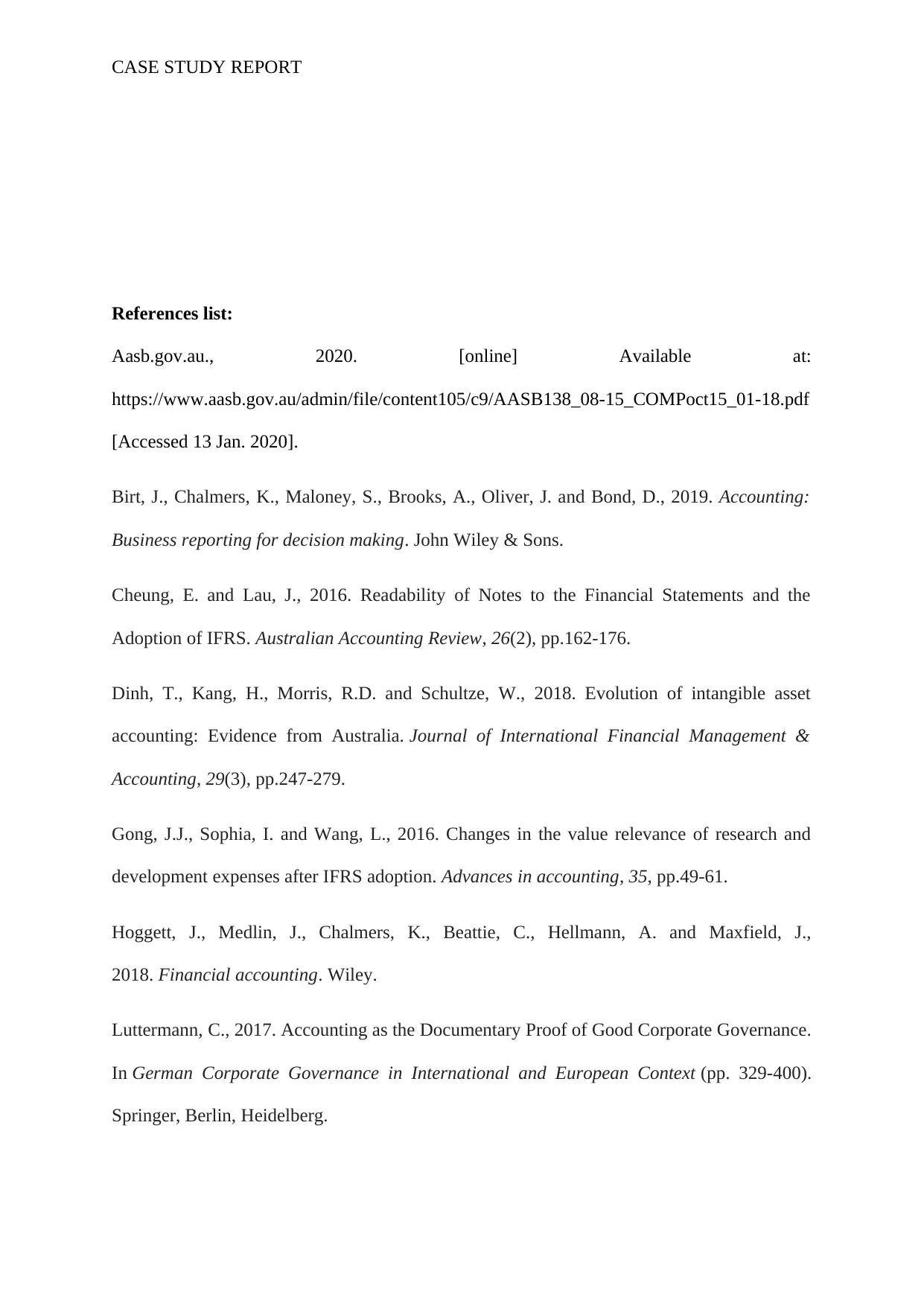
CASE STUDY REPORT
References list:
Aasb.gov.au., 2020. [online] Available at:
https://www.aasb.gov.au/admin/file/content105/c9/AASB138_08-15_COMPoct15_01-18.pdf
[Accessed 13 Jan. 2020].
Birt, J., Chalmers, K., Maloney, S., Brooks, A., Oliver, J. and Bond, D., 2019. Accounting:
Business reporting for decision making. John Wiley & Sons.
Cheung, E. and Lau, J., 2016. Readability of Notes to the Financial Statements and the
Adoption of IFRS. Australian Accounting Review, 26(2), pp.162-176.
Dinh, T., Kang, H., Morris, R.D. and Schultze, W., 2018. Evolution of intangible asset
accounting: Evidence from Australia. Journal of International Financial Management &
Accounting, 29(3), pp.247-279.
Gong, J.J., Sophia, I. and Wang, L., 2016. Changes in the value relevance of research and
development expenses after IFRS adoption. Advances in accounting, 35, pp.49-61.
Hoggett, J., Medlin, J., Chalmers, K., Beattie, C., Hellmann, A. and Maxfield, J.,
2018. Financial accounting. Wiley.
Luttermann, C., 2017. Accounting as the Documentary Proof of Good Corporate Governance.
In German Corporate Governance in International and European Context (pp. 329-400).
Springer, Berlin, Heidelberg.
References list:
Aasb.gov.au., 2020. [online] Available at:
https://www.aasb.gov.au/admin/file/content105/c9/AASB138_08-15_COMPoct15_01-18.pdf
[Accessed 13 Jan. 2020].
Birt, J., Chalmers, K., Maloney, S., Brooks, A., Oliver, J. and Bond, D., 2019. Accounting:
Business reporting for decision making. John Wiley & Sons.
Cheung, E. and Lau, J., 2016. Readability of Notes to the Financial Statements and the
Adoption of IFRS. Australian Accounting Review, 26(2), pp.162-176.
Dinh, T., Kang, H., Morris, R.D. and Schultze, W., 2018. Evolution of intangible asset
accounting: Evidence from Australia. Journal of International Financial Management &
Accounting, 29(3), pp.247-279.
Gong, J.J., Sophia, I. and Wang, L., 2016. Changes in the value relevance of research and
development expenses after IFRS adoption. Advances in accounting, 35, pp.49-61.
Hoggett, J., Medlin, J., Chalmers, K., Beattie, C., Hellmann, A. and Maxfield, J.,
2018. Financial accounting. Wiley.
Luttermann, C., 2017. Accounting as the Documentary Proof of Good Corporate Governance.
In German Corporate Governance in International and European Context (pp. 329-400).
Springer, Berlin, Heidelberg.
⊘ This is a preview!⊘
Do you want full access?
Subscribe today to unlock all pages.

Trusted by 1+ million students worldwide
1 out of 14
Related Documents
Your All-in-One AI-Powered Toolkit for Academic Success.
+13062052269
info@desklib.com
Available 24*7 on WhatsApp / Email
![[object Object]](/_next/static/media/star-bottom.7253800d.svg)
Unlock your academic potential
Copyright © 2020–2025 A2Z Services. All Rights Reserved. Developed and managed by ZUCOL.





